

Reignite your content engine with poignant topics, strategic keywords, and fresh ideas to fuel your organic visibility.
Has the content inspiration well run dry? Luckily, we’re surrounded by a plethora of sources for intel, so don’t work harder than you have to to zero-in on game-changing targets.
Look no further than the SERPs to surface valuable consumer insight from Google itself, mine customer feedback for hidden gems, keep an eye on your search competitors, and leverage handy industry tools to help identify new possibilities and gaps in your content strategy.
Here’s how.
SOURCE FROM SERP FEATURES
Let’s take a look at our first source of inspiration: the Google-approved search terms in SERP features (“People also ask” boxes and related searches, to be exact).
These features are keyword goldmines — both link to new SERPs from terms that are semantically related to the searcher’s original query. As a result, they provide excellent insight into how users follow-up, narrow down, or refine their searches and reveal relevant topics that may be overlooked.
Google has put a lot of effort (and dollars) into understanding and mapping how topics and queries are linked, and these SERP features are the direct result of all that research — Google is literally pointing you to how and what everyone is searching.
Simply put, when it comes to ideating on content opportunities, these SERP features are too valuable to ignore.
“People also ask”
You’re probably quite familiar with this accordion-like feature. The “People also ask” box contains questions related to the searcher’s initial query, which then expand to reveal answers that Google has pulled from other websites.
Not only are PAA questions excellent long-tail additions to your keyword set, they’re also a great resource for content inspiration.
The various ways that they express the same basic question can help you expand on topics — one piece of content could easily answer PAA questions such as “What a photographer needs to get started?” and “What tools do I need to be a photographer?”.
Just try not to fall down the query rabbit hole. While the PAA box used to surface anywhere from one to four Q&A combos, most are “infinite” now and can easily multiply into the hundreds — giving you a seemingly endless supply of SERPs to track.
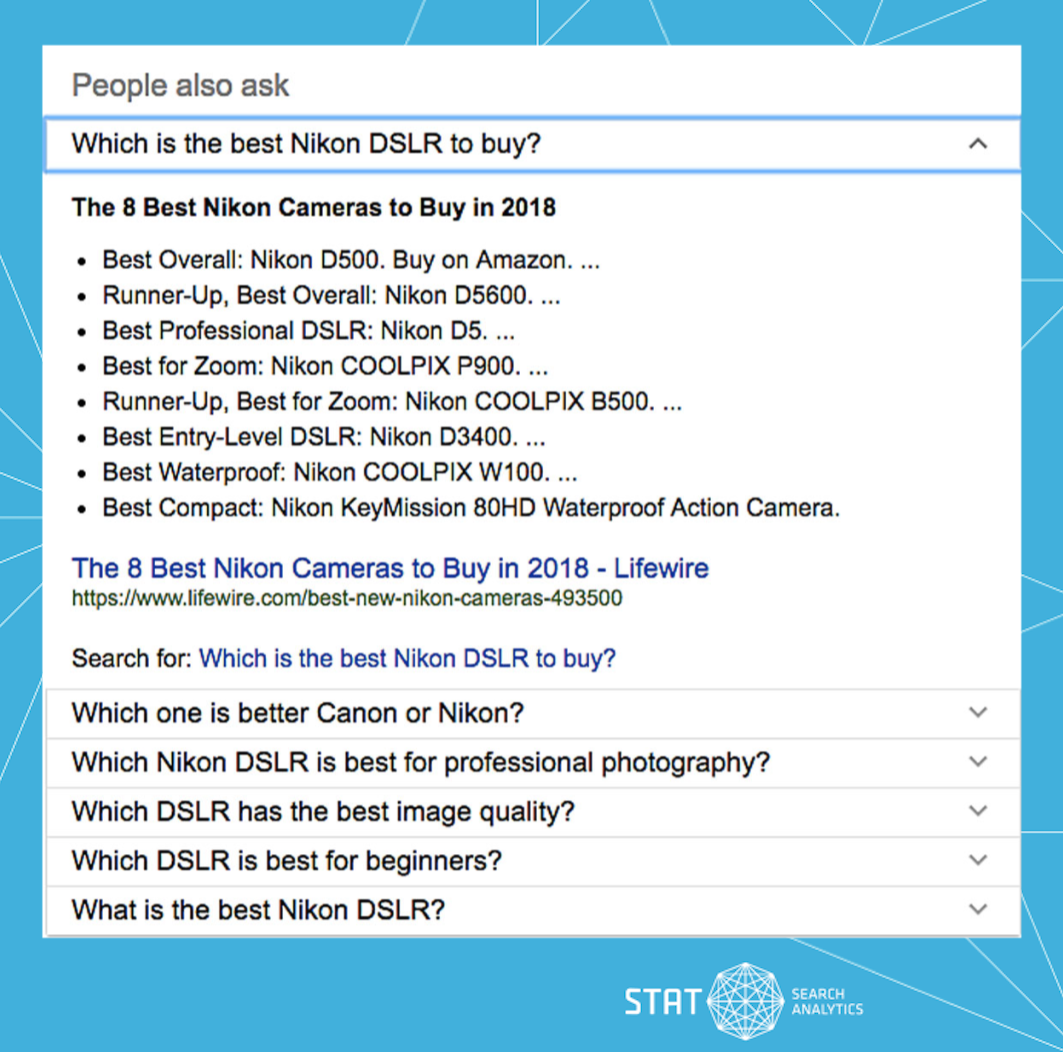
A People also ask result
In order to capture all the goodies hiding in a PAA, we created a handy report.
For each of your keywords that return a PAA box, our .CSV report will list the questions “also asked” (don’t worry, you’ll only get the number of PAAs that exist before things get infinitely overwhelming) and the URLs that Google sourced the answers from, plus the order they appear in.
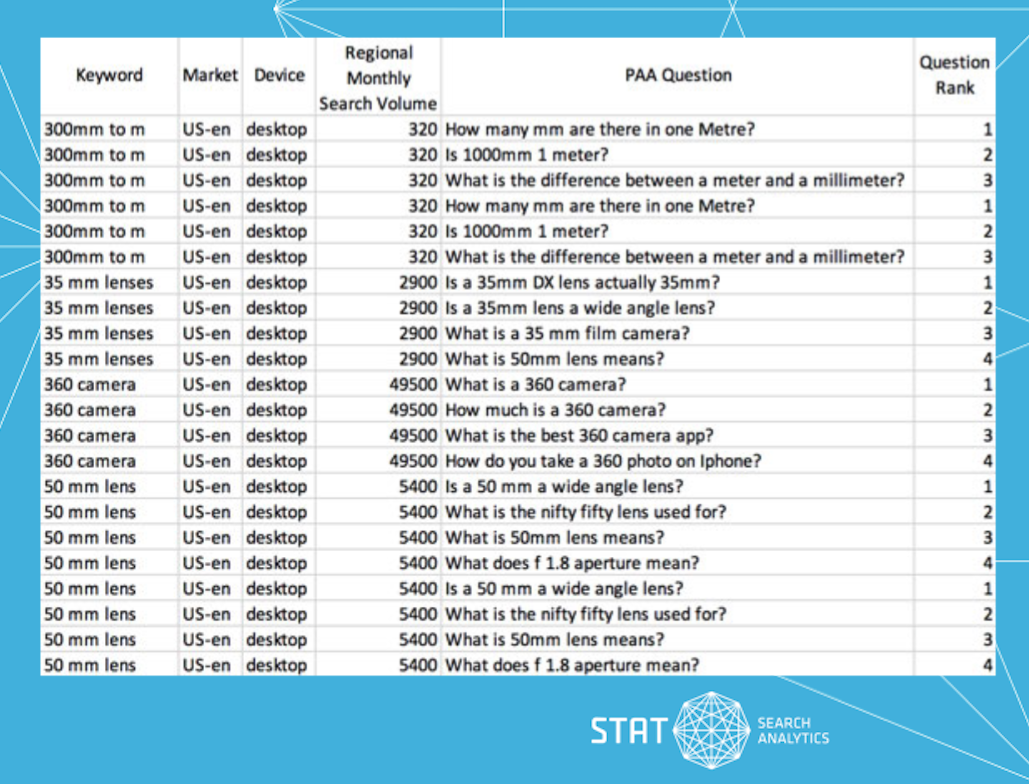
People also ask report
A quick scan will undoubtedly reveal that many of the PAA boxes will return the same questions over and over again, so set about removing those. This will narrow down your PAA keyword list to unique, topically related queries to explore.
“People also ask” questions can be particularly useful to analyze from a branded keyword perspective. They can help you understand the other questions searchers are asking about your brand so you can evaluate how your site answers (or doesn’t answer) those queries.
You’ll want to ensure you address these questions with the content to own that user journey from top to bottom, providing a seamless path to conversion for your audience.
Related searches
Another go-to for content inspiration are the related searches found at the bottom of the SERP that, when clicked, become the search query of a new SERP. These show how a searcher may refine or expand upon their original query.

Related searches in the wild
For instance, if we’re interested in ranking for “best professional cameras,” a quick look at the related searches will reveal alternative SERPs that Google thinks our searchers may be interested in, like “best professional camera for beginner,” “best dslr camera,” and “best point and shoot camera.”
Our related searches report makes it so that you don’t have to manually gather the “Searches related to” yourself — it takes them all and combines them into a crisp and clean .CSV spreadsheet.
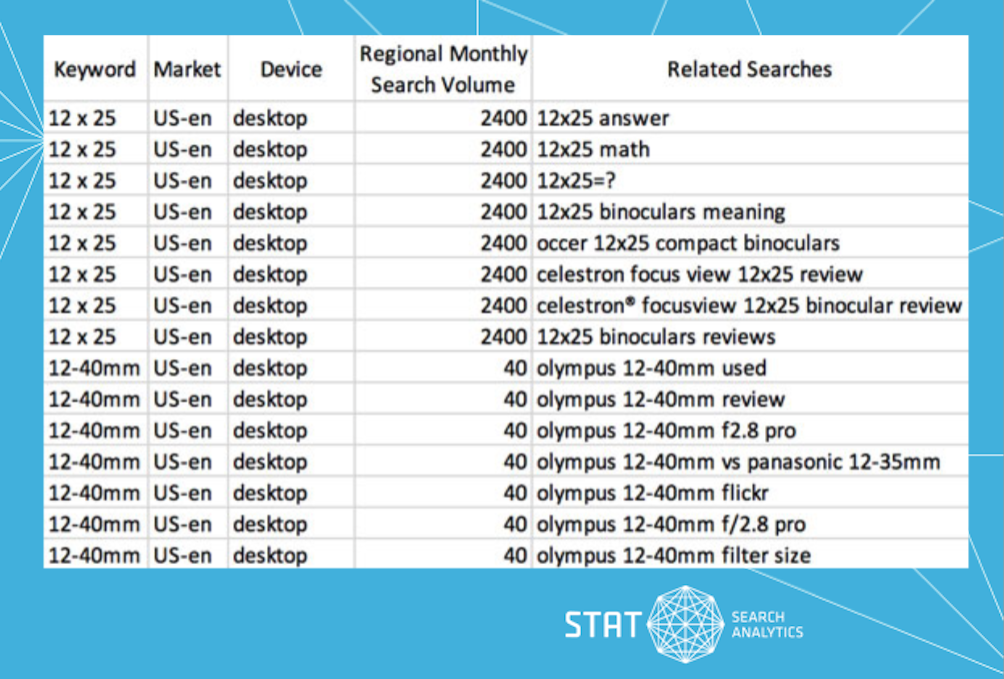
Related searches report
Combine your related search keywords with your findings from the People also ask report and you’re well on your way to compiling your working list of potential queries to track and target with your content.
LISTEN TO YOUR CUSTOMERS
One of our favorite avenues to explore for sparking new content ideas is listening to clients, and we can’t emphasize the importance of doing this enough. Not only is staying in sync with your customers integral to good business, your audience will provide invaluable inspiration when it comes to deciding what content you should plan to spin up next.
Digging into customer feedback and reviews, and analyzing the specific verbiage within, can help guide your approach. There you’ll find poignant topical themes to address, as well as specific queries and phrasing that will resonate with your audience.
And don’t forget to consult customer-facing colleagues for their input on what clients are most concerned about. This will surface additional topics to cover and ensure you’ll be creating content that directly serves the problems your audience is trying to solve.
KEEP AN EYE ON COMPETITORS
Another fruitful source of inspiration is taking a page from your search competitors’ playbooks. Your own visibility is impacted by those vying for the same searcher eyes, so it behooves you to keep your finger on the competitive pulse to stay ahead.
First, identify high-priority keyword segments and any that might benefit from some TLC — where competitors are gaining ground and you’re losing visibility. Then, dig into the specific keywords and competitor content within those segments to find new avenues for opportunity.
We’ve covered how to surface content opportunities via your search competitors in greater detail in case you need a refresher.
LEVERAGE INDUSTRY RESOURCES AND TOOLS
And, naturally, there are some pretty nifty tools that can take care of a lot of the heavy-lifting for you. There are many sources that SEOs often turn to in their research processes, including Keyword Planner, Google Suggest aka (Autocomplete), or even Google Trends for broader topic exploration.
Handily, the keyword suggestions tool in STAT combines inputs from many of these popular sources automatically, as well as pulling in additional keywords that ranking pages also rank for, topic-modeling ideas, and more, allowing you to conveniently bypass the drudgery of manual analysis.
Start with a seed keyword (you can repeat this process as many times as you like), and STAT will offer shiny new suggestions along with estimated search volume to help you zero-in on keywords with the most potential.
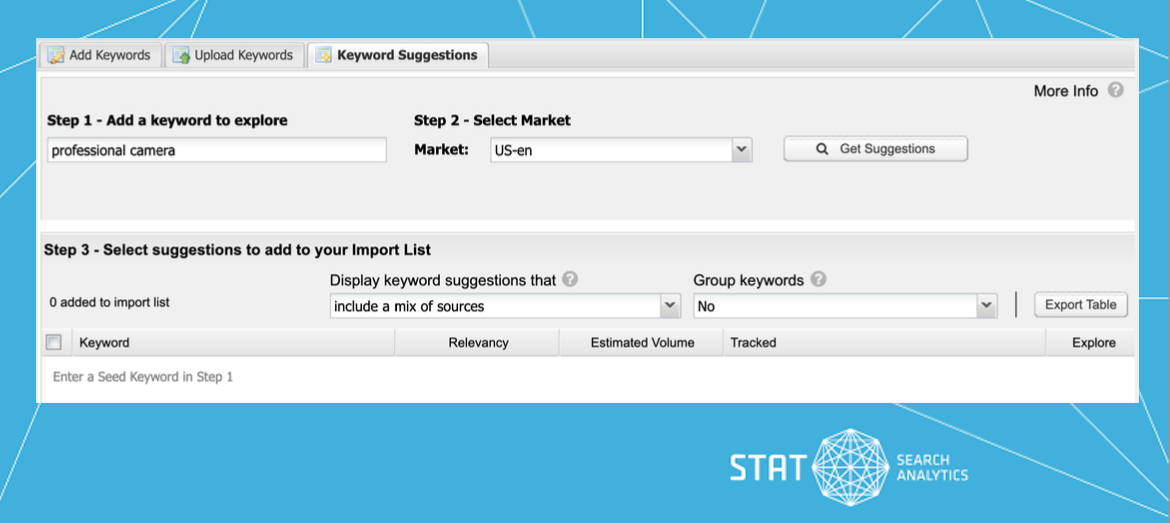
Keyword Suggestions in STAT
Use the filtering capabilities to broaden or narrow the type and scope of the suggestions presented. For example, by excluding your original search term, you may find terms you haven’t thought of, and by filtering for “are questions,” you’ll surface queries that can be golden opportunities to address with new informational content.
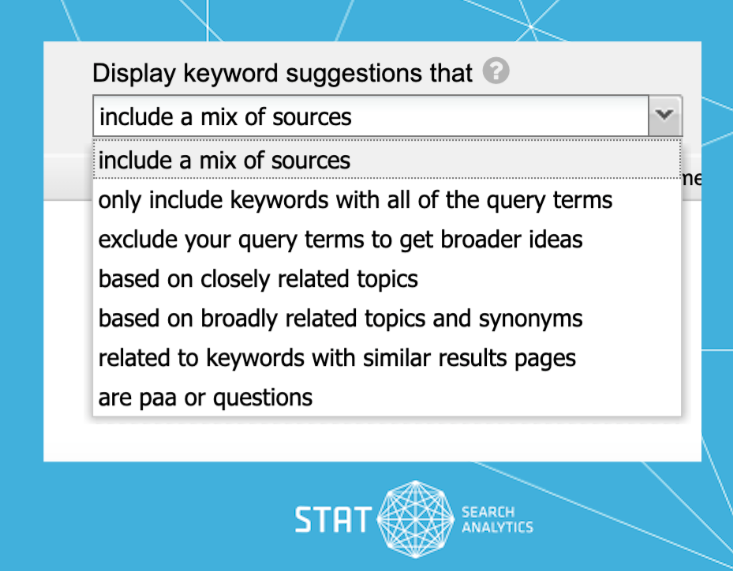
Keyword Suggestions filtering criteria
Use the grouping functionality to cluster your suggestions by their lexical similarity so you can see which keywords are topically related, effectively allowing you to zoom in and out when it comes to the granularity of your segments. This can be helpful for shifting gears between identifying broader topical content ideas and more specific keywords to target.
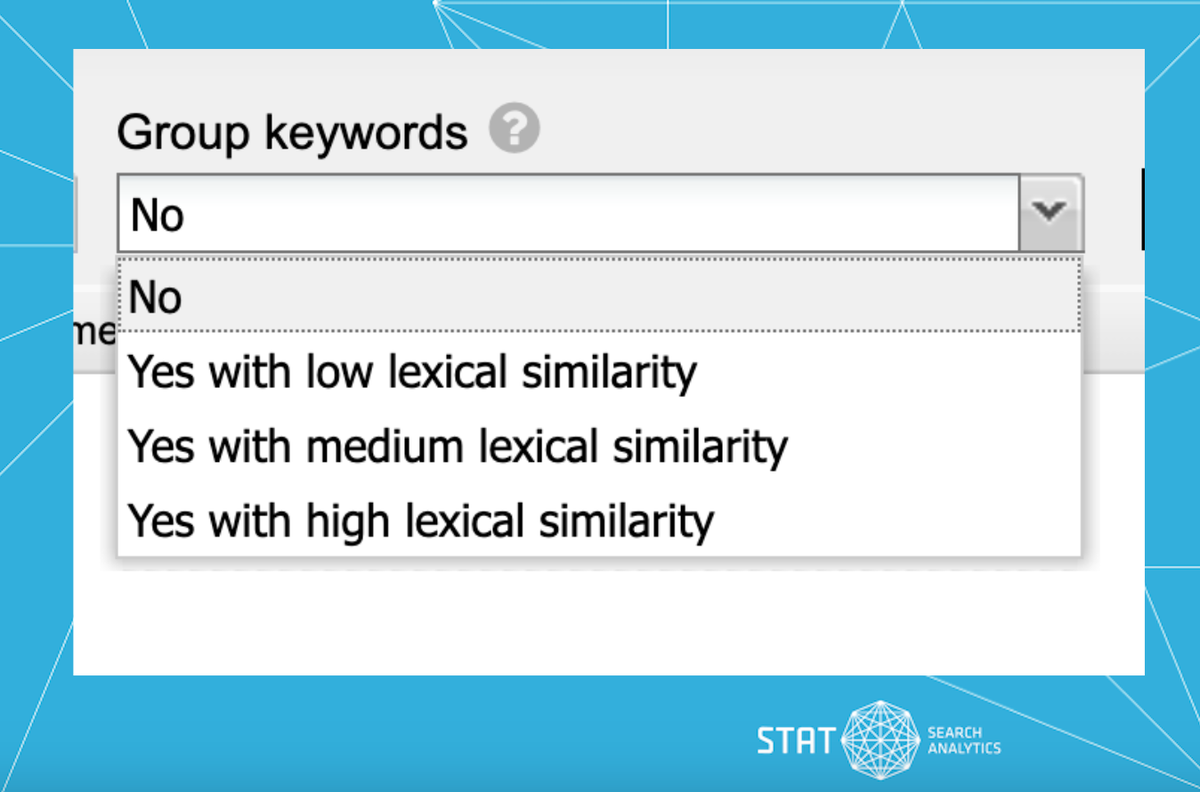
Leveraging machine learning in STAT
For example, if you’re looking for a breadth of topics, selecting “Yes with high lexical similarity” will give you more groups with fewer keywords in each group; if you’re going for depth, “Yes with low lexical similarity” will give you fewer groups with more keywords in them.
Sound intriguing? Check out Keyword Suggestions in action:
EVALUATE YOUR NEW KEYWORDS
By now, you should have plenty of fresh ideas to work with when it comes to potential keywords and topics relevant to your audience. But, you’ll want to be sure to pursue only the most promising of the bunch. To do this, we suggest conducting a little audit of those you’ve surfaced.
First, combine your queries into a master list and do some initial work to weed out any keywords that may have squeaked by but just don’t make sense for your business.
Next, you’ll want to track these terms to gather some initial comparative intel around search volume, as well as get a handle on the search landscape in terms of competitors and SERP features present for each. This will help refine your list to only the most worthwhile queries and topics.
Be sure to remove any keywords with little or no search volume to ensure you’re not investing your time crafting content that no one is looking for.
Just remember though: search volume is relative. Decide what constitutes “low” for you — low search volume may be par for the course for your particular industry or vertical, or the search intent you’re targeting (high intent keywords are often long-tail and low search volume).
So you may just decide you want to keep low search volume keywords in your toolbox.
INFUSE YOUR CONTENT STRATEGY WITH DATA-DRIVEN SUGGESTIONS
Now that you know how to acquire boatloads of content inspiration by analyzing key SERP features, listening to your customers, investigating competitors, and harnessing time-saving tools like Keyword Suggestions in STAT, we hope you won’t find yourself wanting when it comes to time to create new content.
If you’re interested in giving STAT’s specialized SERP feature reporting and Keyword Suggestions a whirl, feel free to drop us a line and we’d be happy to give you a personalized tour.
Related Posts

A little competitive analysis goes a long way when it comes to crafting a data-driven content strategy.
Content ideation
7 min
27 Nov 2023

There’s prime opportunity to snag more visibility on the SERP with featured snippets — here’s how.
Content ideation
7 min
24 Aug 2023

We’ll show you how to navigate the treacherous tides of search and set sail for SERP feature glory.
Content ideation
15 min
16 Mar 2023

 Content ideation | On-page SEO
Content ideation | On-page SEO 